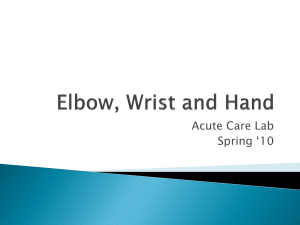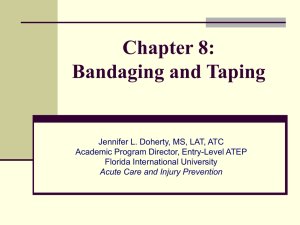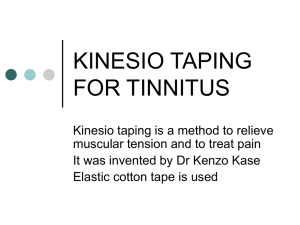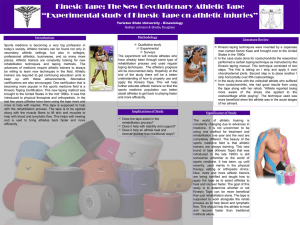Chapter 8: Bandaging and Taping
advertisement
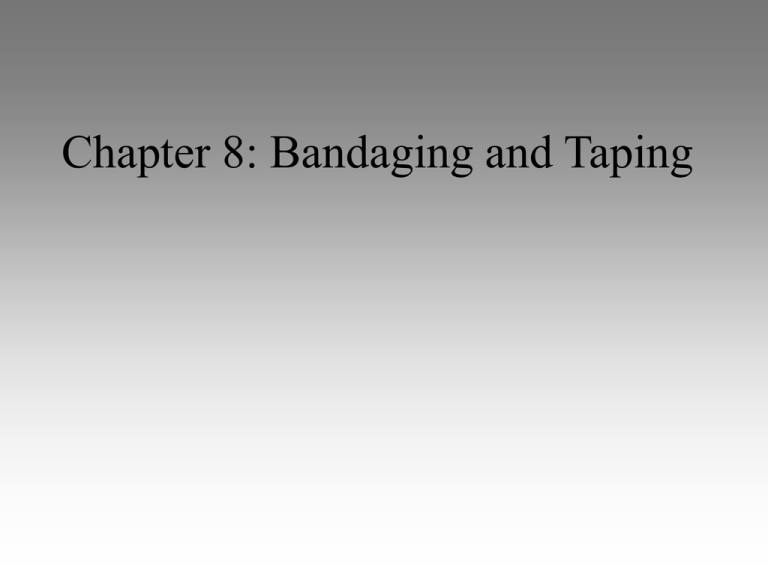
Chapter 8: Bandaging and Taping Bandaging • Will contribute to recovery of injuries • When applied incorrectly may cause discomfort, wound contamination, hamper healing • Must be firmly applied while still allowing circulation Materials • Gauze- sterile pads for wounds, hold dressings in place (roller bandage) or padding for prevention of blisters • Cotton cloth- ankle wraps, triangular and cravat bandages • Elastic bandages- extensible and very useful with sports; active bandages allowing for movement; can provide support and compression for wound healing • Cohesive elastic bandage- exerts constant even pressure; 2 layer bandage that is self adhering; Elastic Bandages • Gauze, cotton cloth, elastic wrapping • Length and width vary and are used according to body part and size • Sizes ranges 2, 3, 4, 6 inch width and 6 or 10 yard lengths • Should be stored rolled • Bandage selected should be free from wrinkles, seams and imperfections that could cause irritation Elastic Bandage Application • Hold bandage in preferred hand with loose end extending from bottom of roll • Back surface of loose end should lay on skin surface • Pressure and tension should be standardized • Anchor are created by overlapping wrap – Start anchor at smallest circumference of limb • Body part should be wrapped in position of maximum contraction • More turns with moderate tension vs. fewer turns with maximum tension • Each turn should overlap by half to prevent separation • Circulation should be monitored when limbs are wrapped Elastic bandages can be used to provide support for a variety scenarios: • • • • • • Ankle and foot spica Spiral bandage (spica) Groin support Shoulder spica Elbow figure-eight Gauze hand and wrist figure-eight • Cloth ankle wrap Triangle and Cravat Bandages • Cotton cloth that can be substituted if roller bandages not available • First aid device, due to ease and speed of application • Primarily used for arm slings – Cervical arm sling – Shoulder arm sling – Sling and swathe Cervical Arm Sling • Designed to support forearm, wrist and hand injuries • Bandage placed around neck and under bent arm to be supported Shoulder Arm Sling • Forearm support when a shoulder girdle injury exists • Also used when cervical sling is irritating Sling and Swathe • Combination utilized to stabilize arm • Used in instances of shoulder dislocations and fractures Taping • Historically an important part of athletic training • Becoming decreasingly important due to questions surfacing concerning effectiveness • Utilized in areas of injury care and protection Tape- Injury Care • Retention of wound dressing • Stabilization of compression bandages controlling internal and external bleeding • Support of recent injuries in an effort to prevent additional trauma • Provide stabilization while athlete undergoes rehabilitation Tape- Injury Protection • Used to protect against acute injuries • Limits motion or secures special device Non-elastic White Tape • Great adaptability due to: – – – – Uniform adhesive mass Adhering qualities Lightness Relative strength • Help to hold dressings and provide support and protection to injured areas • Come in varied sizes (1”, 1 1/2” , 2”) • When purchasing the following should be considered: • Tape Grade – Graded according to longitudinal and vertical fibers per inch – More costly (heavier) contains 85 horizontal and 65 vertical fibers • Adhesive Mass – Should adhere regularly and maintain adhesion with perspiration – Contain few skin irritants – Be easily removable without leaving adhesive residue and removing superficial skin • Winding Tension – Critically important – If applied for protection tension must be even Elastic Adhesive Tape • Used in combination with non-elastic tape • Good for small, angular parts due to elasticity. • Comes in a variety of widths (1”, 2”, 3”, 4”) Preparation for Taping • Skin surface should be clean of oil, perspiration and dirt • Hair should be removed to prevent skin irritation with tape removal • Tape adherent is optional • Foam and skin lubricant should be used to minimize blisters • Tape directly to skin • Prewrap (roll of thin foam) can be used to protect skin in cases where tape is used daily • Prewrap should only be applied one layer thick when taping and should be anchored proximally and distally • Proper taping technique – Tape width used dependent on area – Acute angles = narrower tape • Tearing tape – Various techniques can be used but should always allow athlete to hold on to roll of tape – Do not bend, twist or wrinkle tape – Tearing should result in straight edge with no loose strands – Some tapes may require cutting agents Rules for Tape Application • Tape in the position in which joint must be stabilized • Overlap the tape by half • Avoid continuous taping • Keep tape roll in hand whenever possible • Smooth and mold tape as it is laid down on skin • Allow tape to follow contours of the skin Rules for Tape Application (cont.) • Start taping with an anchor piece and finish by applying a locking strip • Where maximum support is desired, tape directly to the skin • Do not apply tape if skin is hot or cold from treatments Additional Taping Information • Removing adhesive tape – Removable by hand • Always pull tape in direct line with body (one hand pulls tape while other hand presses skin in opposite direction – Aid of tape scissors and cutters may be required • Be sure not to aggravate injured area with cutting device – Also removable with chemical solvents Taping Supplies • • • • • • • Razor (hair removal) Soap (skin cleaning) Alcohol (oil removal) Adhesive spray Prewrap material Heel and lace pads White non-elastic tape • Elastic adhesive tape • Felt and foam padding material • Tape scissors • Tape cutters • Elastic bandages Common Foot Taping Procedures Arch Technique 1 (to strengthen weakened arches) Arch Technique 2 (for longitudinal arch) Arch Technique 3 (X teardrop arch and forefoot support) Arch Technique 4 (fan arch support) LowDye Technique (Management of fallen arch, pronation, arch strains and plantar fascitis) ( Sprained Toes Bunions Turf Toe (prevents excessive hyperextension of metatarsophalangeal joint) Hammer or Clawed Toes Fractured Toes Common Ankle Taping Procedures Routine Non-Injury Taping • Routine Non-injury taping • Closed Basket Weave – Used for newly sprained or chronically weak ankles • Open Basket Weave – Allows more dorsiflexion and plantar flexion, provides medial and lateral stability and room for swelling – Used in acute sprain situations in conjunction with elastic bandage and cold application Closed Basket weave (Gibney) Technique Open Basket Weave Continuous-Stretch Tape Technique Common Leg & Knee Taping Procedures Achilles Tendon (prevent Achilles over-stretching) Collateral Ligament Rotary Taping for Knee Instability Knee Hyperextension (Prevent knee hyperextension, provide support to injured hamstring or slackened cruciate ligament) Patellofemoral Taping (McConnell technique) • Helps to manage glide, tilt, rotation and anteroposterior orientation of patella • Accomplished by passively taping patella into biomechanically correct position • Also provides prolonged stretch to softtissue structures associated with dysfunction Patellofemoral Taping (McConnell technique) Common Upper Extremity Taping Procedures Elbow Restriction (Prevents elbow hyperextension) Wrist Technique 1 (Mild wrist sprains and strains) Wrist Technique 2 (Protects and stabilizes badly injured wrist) Bruised Hand Sprained Thumb (Provide support to musculature and joint) Finger and Thumb Checkreins


